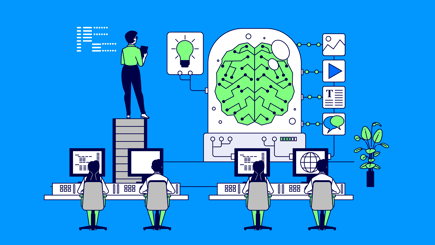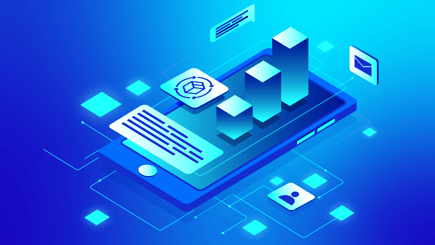.webp)
Digital transformation: What it is, how to achieve it, and the importance of this process
IIEBS Digital School defines digital transformation as a process that seeks the application and use of new technologies so that an organization can benefit and increase its productivity in short periods of time, seeing as cultural and organizational changes are involved.
It entails applying innovative digital resources to processes, products, or business assets to improve efficiency, add value to the customer, manage risks wisely and open new opportunities that generate revenue or certain benefit to the brand that decides to begin a digital transformation process.
Organizational culture and its relationship with digital transformation
Organizational culture plays a very important role in the digital transformation processes because if a cultural change is not generated and represented by company leaders, it can fail at any stage of this new re-adaptation.
Continuing with the cultural transformation, it can be said that changes in work processes that incorporate a collaborative approach are of utmost importance. They must be based on collaborative and interdisciplinary work, analyzing what aspects need work for a group or team to be considered as such, as well as assigning organizers and role analysis.
It's necessary to go a step further in order to continue in this direction. Analyzing the group's evolution is key to solving questions such as: How can we know if the group is healthy, how can we know which impediments are altering its development, and what needs to be improved? Among others.
The key point to assess is where the analysis vectors come together. That is, the attitude towards change is modified when basic fears (detailed in other meetings and summarized as fear of attack and fear of loss), which produce stereotypes, are increased or resolved. The cone is also the outline of every task and it will always be the axis from which each vector is viewed.
How is change represented in a workgroup?
Everything that happens in a group can be represented by this diagram. It will point out a spiral reaction that ends in a situation of resistance to change. The group work is the one that configures this spiral and the interpretation vectors are used to reach the nucleus where resistance is installed. The inverted cone diagram is an evaluation scale based on the observation of group models. This is the reference scale with which to build interpretations.
This cone has a base and an apex, but within it, there is a dialectical spiral because a thesis, antithesis, and synthesis come into play, which then becomes a thesis again and is confronted by a new antithesis to generate a more evolved synthesis. The cone is distributed as follows:
- The manifested or explicit content is located at the base, that which is discovered through observation.
- At the apex are the implicit situations, those that are latent and that will require a reading and interpretation process.
- The spiral graphs the dialectic clarification movement that goes from explicit to implicit, explaining the latent element that acts as a disturbing factor.
Why is digital transformation implicit in discovery?
As we already know, all learning produces the emergence of basic fears, which are important points to be solved during the learning process because this is where the universals will be located, as basic fears, configure a situation that resists change. So the reading of the processes is in the direction of these movements, which, through a dialectical analysis, integrate a game of opposite senses.
Now, we are going to analyze the inverted cone scheme where we have the vectors, which are like peepholes that will allow us to look at the whole process from different points of view.
Before delving deeper, it's important to mention that the term vector has two meanings:
1) Transport or conductor (from Latin vector: that which conducts): Thus we say that a missile is a vector of an explosive charge.
2) In mathematics, a vector is an oriented segment that has length, direction, direction, and a point of application as its constituent elements.
Pichón takes up the concept of vector according to Kurt Lewin's Field Theory, which defines it as the different forces present in a field, where "field" represents the totality of facts that converge at a given moment, allowing consideration and analysis of any behavior.
In simpler words, it consists of analyzing a group process from different vectors. Reading a process implies interpreting it and making sense of certain learned criteria, which will be provided by the cone diagram. It will also allow approaching the group reading and interpretation in one sense, opening up the possibility of finding multiple truths. This tool requires a critical attitude that looks at oneself as well as the group. This means that interpretations can be reconstructed, overcoming the illusion of knowing everything.
Usually, for educational reasons, we list the vectors in the order presented, but this doesn't mean that belonging comes first, then cooperation, and then communication. They are coexistent and cooperative traits that are presented all together. Whether someone, from the perspective of group coordinator or facilitator, gives one of these elements more importance than the others will have to do with an instrumental attitude.
Let's begin by describing each vector:
-
Affiliation and belonging:
It's the only vector that has two differentiated nuances. Pichón seeks to differentiate between affiliation and belonging, alluding to degrees of integration. Affiliation ("becoming a child") occurs when the member feels identified with some characteristics of the group process they have decided to be a part of, but still, keep a certain distance, they don't feel as if they belong completely.
Tenure ("tenure completely, forever") is when the subject feels fully integrated into the group; so much so that they come to feel that this collectivity would not be the same if they were absent. In other words, affiliation and belonging describe the same vector, with differences in gradation.
-
Cooperation:
Cooperation comes from having common needs or problems and working together to solve them. It implies a certain level of commitment from each person, as well as higher levels of solidarity, closeness, and affectivity. It refers to a member's willingness to collaborate, sometimes even silently, with the group's productivity and the task. For there to be cooperation, it is necessary to define what we require, what we need, what goals we propose, what objectives, what path we wish to follow in order to reach that goal, etc.
-
Communication:
It has to do with the types and styles of message emission and reception: where do the messages go, are they clear, are the messages translated for the other to understand, how are they spoken, how are they listened to, do they all speak at the same time, do they wait while speaking, or what is the communication like?
In general, communication is the transferring of information (message) from one point in space to another. In particular, it is the human ability to share emotions, thoughts, and knowledge. If learning or modification is dialectical - as it should be for a healthy subject - it is also necessary to return the communication, called feedback.
-
Learning:
These are the types of contents, attitudes, and capabilities inscription. Feeling is involved in attitudes, thinking is involved in contents, and doing is involved in capacities. It refers to 1) the incorporation of new knowledge, and 2) the dialectical modification of beliefs and convictions (subjective truths, dogmas, opinions, ideologies) so that they coincide with the facts of reality. Pichón Rivière (2007) also defines it as "instrumental appropriation of reality".
In Spanish, although they share the same etymology, aprender and aprehender are considered paronyms, that is, words that are similar but have different meanings. “To learn” means to incorporate knowledge, while “to apprehend” means to capture or catch. However, both terms are considered associated, since the link between the subject and the object of knowledge implies both the incorporation of knowledge and capturing the essence of the object in all its aspects.
-
Pertinence:
In Operational Groups, relevance refers essentially to the implicit task, since it may occur that topics related to the explicit task are dealt with, causing the whole to not function relevantly or lower its productivity. Or the other way around: in the explicit, topics with no apparent connection to the explicit task are touched upon, and yet there is relevance.
Relevance is doing and expressing the things that are convenient at the moment. That is, it analyzes the relationship of the group with a specific task and how this group relates to its object: does it marginalize it, denigrate it, idealize it, what attention does it pay to it, does it investigate, does it not investigate, is it interested in the subject or how does it react?
-
Telé:
The telé is one of the six vectors of the cone. The term was coined by the American psycho-sociologist Jacob Levy Moreno, creator of psychodrama and sociometry. It was originally defined as "the positive or negative disposition to work with a group member". Pichon Rivière associates telé with his particular vision of transference as a permanent phenomenon in every relationship of the individual with his peers.
The telé continues as an implicit component of our feelings towards that person, however, it is more noticeable in that first moment due to the lack of the rational component and the modification of the relationship generated by feedback and learning.








